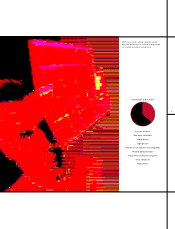Casio 2000 Annual Report Download - page 20
Download and view the complete annual report
Please find page 20 of the 2000 Casio annual report below. You can navigate through the pages in the report by either clicking on the pages listed below, or by using the keyword search tool below to find specific information within the annual report.
18
bonds outstanding are converted into common stock, was
5.8% of shares outstanding. All dilution is associated with
1.9% domestic convertible bonds due in February 2004
with a conversion price of ¥1,502.4. Net income per share
was ¥22.73, compared with a net loss per share of ¥30.90
in the previous term.
ANALYSIS OF GROUP OPERATIONS The consolidated
accounts reflect the operations of the parent company,
manufacturing and marketing subsidiaries in Japan and
overseas, and subsidiaries engaged in related activities.
The Casio Lease Co., Ltd., which engages in the leasing
of computer systems, is the principal company in the
latter group.
Casio Micronics Co., Ltd. is engaged in the manufacture
and sale of film devices, and provides bump processing. In
recent years, strong demand has fueled high growth in sales
to electronics companies outside the Casio Group.
For the fiscal year ended March 31, 2000, there were 67
consolidated subsidiaries and nine affiliates accounted for
by the equity method, compared with 61 consolidated sub-
sidiaries and nine equity-method affiliates during the
previous term.
LIQUIDITY AND FINANCIAL RESOURCES
ANALYSIS OF CASH FLOWS The statement of cash flows for
the fiscal year under review was prepared in accordance
with new standards for preparing statements of cash flows
in Japan and is not comparable with statements for
previous years, which were prepared voluntarily for the
convenience of readers outside of Japan (See note 2).
Net cash provided by operating activities was ¥45,559
million, including income before income taxes of ¥12,275
million and depreciation of ¥31,926 million. Of this, the
depreciation of leasing assets, including systems leased to
customers as part of the Data Processing Equipment cate-
gory, was ¥14,879 million, compared with ¥14,423
million a year earlier. An increase in notes and accounts
payable, related to robust growth in the electronic compo-
nents business, provided cash of ¥17,110 million.
Net cash used in investing activities was ¥26,478 mil-
lion. Payments of acquisitions of tangible fixed assets used
cash of ¥31,651 million, and payments of acquisitions of
intangible fixed assets used cash of ¥2,822 million. A de-
crease in time deposits provided cash of ¥11,460 million.
Capital investment included ¥20,166 million (on a con-
tract basis) for leasing assets, compared with ¥17,863
million during the previous term.
CASH FLOW AND CAPITAL INVESTMENT
Millions of yen
2000 1999 1998
Net income (loss) ¥16,173 ¥ (8,534) ¥11,738
Depreciation 30,220 31,001 30,442
Cash flow 36,393 22,467 42,180
Capital investment 35,546 31,212 53,824
Note: Capital investment for fiscal 1998 included ¥21,461 million for the acquisition of the land and building of the new headquarters in December 1997.
Net cash used in financing activities was ¥23,631 mil-
lion. The largest use of cash in the category was a net
decrease in short-term borrowings of ¥19,936 million, fol-
lowed by payments of cash dividends of ¥3,400 million.
In aggregate, cash and cash equivalents at end of year, in-
cluding the effects on cash of changes in consolidation,
decreased ¥4,959 million to ¥113,751 million.
ANALYSIS OF FINANCIAL POSITION Total current assets
declined ¥10,173 million to ¥312,315 million, largely
owing to a ¥21,860 million decrease in cash and time
deposits. Inventories increased ¥4,683 million to ¥80,507
million, and inventory turnover worsened during the term
after three consecutive years of improvement. To improve
inventory management in coming terms, a supply chain
























